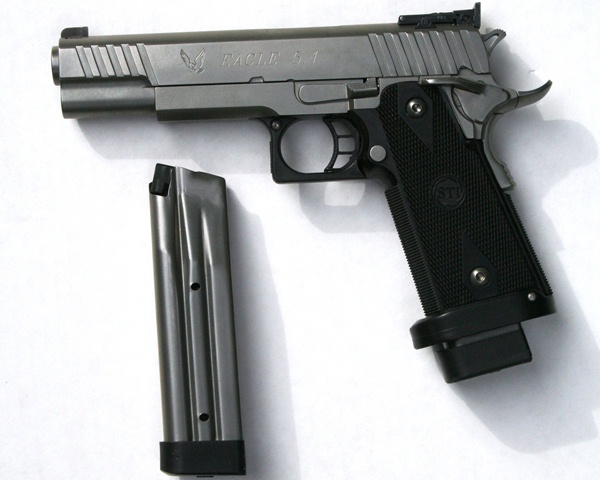Robar calls their NP3 process “the ultimate firearms finish”. I don’t have enough data points to confirm or deny that claim but I have to admit I have been very happy with it on my STI Eagle 5.1 (link is to a 5.0, the 5.1 is obsolete). The bluing on my Ruger P-89 wore off after a few years of use and the baked on black finish on my customized Remington 700 is easily scratched. The black anodized aluminum on my AR-15 appears to hold up well although it hasn’t been exposed to nearly as much abuse as my pistols have.
After I got my STI back from being repaired it looked like one of those cars you see sometimes with a the hood a different color from the rest of the body and a door or two with still different colors. I took it to the range a put a few rounds through it to verify the functionality and the very next day sent it and several of my magazines to Robar for an NP3 make over.
When I called and asked how long it would take before I would get my gun back they said “we are currently running five to six weeks”. It took four weeks to the day.
They disassembled the gun, stripped all the old finish off, and treated most of the internal parts as well as the external. Here is what they say about it:
What is NP3?
NP3 is a surface treatment for steel and metal alloys that combines sub-micron particles of PTFE (polytetrafluoroethylene), otherwise known as Teflon, with electroless nickel.NP3 – THE PROCESS
The application of NP3 is auto-catalytic, that is, not requiring any form of electricity. This process is preferable to standard electrolytic plating as all active surfaces are evenly plated, which is not the case with any electrolytically deposited coating. With Robar’s well-equipped laboratory, coating thickness can be maintained to within .0002″ or two ten thousandths of one inch, guaranteeing consistent quality coatings. With the PTFE evenly distributed and locked into the nickel-phosphorus matrix, NP3 is a true composite. If wear occurs, fresh particles of PTFE are exposed to keep the opposing surfaces lubricated throughout the life of the coating.NP3 – THE ADVANTAGES
- Very accurate and even coatings on all activated surfaces.
- No lubrication is needed on opposing surfaces.
- Cleaning is minimal, usually requiring only a soft cloth.
- Permits firing for longer periods of time between cleaning, as dirt and powder residue has no wet or oily surface to cling to.
- NP3 has a micro hardness of 48-51 Rockwell as plated (nickel matrix).
- NP3 is very corrosion resistant, a 1 mil (.001) coating exceeding a 240 hour salt spray test.
- NP3 has a high lubricity and low friction co-efficient; therefore, the life expectancy of a firearm will be greatly increased due to reduced friction wear.
- The coating is strippable with no effect on the base metal, allowing other coatings to be applied or a new coating of NP3 to be applied, if necessary.�
- NP3 plated onto stainless steel guns will prevent galling, a problem common with stainless steel.
- NP3 is a satin gray, non-reflective color ideal for all firearms.
- NP3 can be plated to all internal parts giving a smoothness to the action not found with any other coating.
- In cases where the NP3 has been perforated, the corrosion shows no tendency to spread or migrate under the coating.
- NP3 is guaranteed against corrosion, peeling or flaking for the lifetime of the firearm.
I think it looks great:

Before I use it for carry or competition I will take it to the range and do some more functional testing. When I got the gun back after getting the original NP3 finish I discovered the gun had a tendency to go full auto on me. I had to take it back to the gunsmith for some minor tweaking of the fire control system. I don’t know if it was a disassembly/assembly error or the slick Teflon on some critical surfaces that caused it to misbehave.
If you have a gun in need of a new finish I strongly suggest you consider the NP3.

To ask the nosy, rude question, how much did said surface treatment cost you?
I’ve had two of my guns make the trip north from Tucson to Robars for work over the past three years. My G19 got the NP3 treatment and I am very pleased with it so much that I may send my Springfield up later next year.
I like how it looks and agree that it is easier to clean and uses less lubrication.
The price list is here. But they are having a special this month for 10% off.
Have you had a chance to do functional testing yet? The finish looked very nice. Thanks for bringing an example of the final product down to my office :).
Not yet. It may be as late at Thursday evening before I get a chance.
I send my stuff up to Walt Birdsong for his “Black-T” finish. What I like about that finish is that it gets applied to every part of the item including springs and screws. And I’ve got a pistol that I had done almost 20 years ago that still has no finish wear.
I had the Roguard treatment to a pair of Mossberg 590 shotguns about 7 years ago. I also have a set of match EAA Witneses n 9mm with the Roguard on the slide and NP3 on the frame, all internal parts and magazines. Smooth action and cycling, not mark, and still slick as ever. Money well spent.